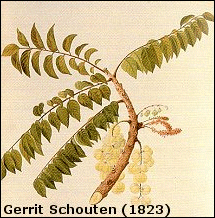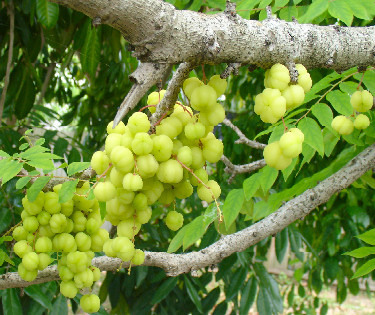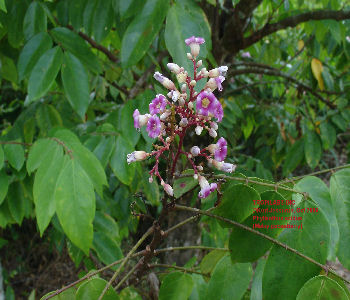 |
 |
PHYLLANTHUS ACIDUS L. - OTAHEITE GOOSEBERRY. Synonyms
SynonymsPhyllanthus distichus, Cicca acida, Cicca disticha L. Common name Aamloki, Wild plum, Iba, Tahitian gooseberry, Otaheite gooseberry, Malay gooseberry, Tjerme, Tjareme, Jimbling, Country gooseberry, Manzana estrella, Groselha, Indian gooseberry, Cherme grosella. Family Euphorbiaceae (Spurge family). Overview Tahitian gooseberry is a small tropical tree with ovate pointed leaves that grows up to 50 feet tall. Tahitian gooseberry bears acidic fruit in abundance on the branches. It has reddish flowers and pale-yellow waxy fruit, 3/4 - 1" thick and is 6-8 ridged; in the center is a hard stone containing 4-6 seeds. The yellow fruit of the Tahitian gooseberry is edible and tastes sour; it is one of the few members of the Euphorbiaceae family that has edible fruit. The tart flesh is used as a flavoring or made into jelly in Suriname. In India, the root bark is used for tanning while the young leaves are used as greens. The fruit contains antioxidants. Medicinal applications As a liver tonic in India; the acrid latex obtained from various parts of the tree is emetic (causes vomiting) and purgative (strong laxative). Leaf extracts exhibit strong anti-inflammatory, analgesic and antioxidant properties. It is also used as a remedy for bronchitis and to treat digestive disorders. The leaves are used as a demulcent (relieves inflammation) against gonorrhea. Externally, the root is used to treat psoriasis of the soles of feet. Hardiness USDA zone 10 - 11. Propagation Seeds and cuttings. Culture Full sun and moist soil. The gooseberry can be grown in Florida although this is a tropical plant. |


|
For the right freight rate, shipping charges, conditions and delivery service, please visit our Webstore page! |